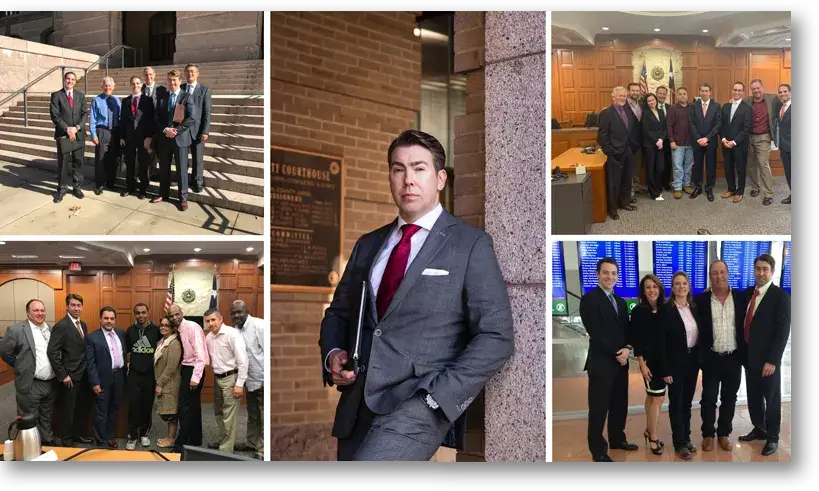Houston Injury Lawyer
If you or a loved one has been injured or killed by the negligence of another, Gilde Law Firm is here to make sure you get justice.
We Believe. We Fight. We Win.
This is Gilde Law Firm’s motto, and it encapsulates the beliefs and ideals that guides our actions on behalf of every client and every case. We believe in you and your case; we fight during every phase of litigation for you; and we win the compensation you deserve to right the wrong that was done to you. We take the time to get to know you and understand your needs. We want to help bring order back to your life, and we put all our years of education, knowledge, skill, and experience toward fighting on your behalf and obtaining excellent results for you, as we have done for many clients many times before.
Houston injury trial attorney Bradford Gilde is a trial lawyer who has worked with and for some of the best law firms in the country. Attorney Gilde has taken on just about every kind of personal injury matter there is, and he has worked cases from every angle – from accident investigation to trial preparation, from settlement negotiations to courtroom appearances, and from mediation to jury verdicts.
In addition to running a law firm and serving his clients on a daily basis, Attorney Gilde practices and teaches the Japanese martial art of Judo. Judo has informed Attorney Gilde’s philosophy as a trial lawyer and strategist, helping him be a legal fighter who is constantly moving, knowing when and how to act and react offensively and defensively, fighting smaller and leaner than his opponent, and understanding when and how to either strike or give way and allow his opponents to defeat themselves. In addition, Attorney Gilde is also a student, teacher, and coach of trial advocacy. As a student, he was classically trained at South Texas College of Law’s “Program” and has continued to study other methods of advocacy, including being a Master’s Graduate form the Keenan Trial Institute. As a teacher and coach, Attorney Gilde returned to his alma mater to do both immediately after graduating and has taught and coached trial advocacy for over fifteen years. As a result of both his philosophy and keen education and experience, Attorney Gilde possesses the rare ability to see both the big picture and the minute details, which makes him extremely effective when strategizing and fighting his opponents in court.
A Comprehensive Houston & National Personal Injury Law Practice
We handled a wide range of cases over the years and are prepared to take on any case, no matter the size or how seemingly straightforward or complex. Let Gilde Law Firm help you win your case involving any personal injury or negligence case in Houston and nationally. Our practice includes all of the following areas:
Catastrophic Injury – We help people with the most serious injuries, including traumatic brain injuries, spinal cord injuries, burn injuries, amputations, fractures, and internal injuries.
Wrongful Death – We help spouses, children, and parents recover compensation after the loss of a loved one, and we punish those who took the loved one’s life away.
Trucking Accidents – Our practice includes the most complex and difficult accident cases involving tractor-trailers and other commercial vehicles, including truck underride/override accidents, jackknife accidents, rollover crashes, and others.
Auto Accidents – We help people hurt in crashes with negligent drivers, drunk drivers, distracted drivers, and reckless drivers. Our experience in auto accident cases prepares us to take on cases involving rideshare drivers, construction zone accidents, multi-vehicle crashes, defective road and highway design accidents, and other less common or more complex causes of auto accidents.
Other Motor Vehicle Accidents – Gilde Law Firm represents motorcycle riders, bicyclists, pedestrians, and e-scooter operators injured in motor vehicle accidents. We take on boating accidents as well.
Dram Shop Liability – In our quest to gain full accountability and maximum compensation for accident victims, we hold bars and restaurants liable for overserving intoxicated individuals or minors who then go out and cause a crash.
Mass Torts – When pharmaceutical companies and manufacturers harm people by the hundreds or thousands with their dangerously unsafe or defective products and drugs, we are ready to take them on and hold them fully accountable for the damage they’ve inflicted.
Defective Products – We hold product makers strictly liable for defective design or defective manufacturing that cause needless injuries and untold misery. We hit the corporate giants in their pocketbook and make sure they change their ways so that society is safer for all.
Plant, Industrial, & Refinery Explosions – Houston’s booming economy owes a lot to the energy sector, but that doesn’t excuse employers and companies from their obligations to operate safely within the bounds of the law and common sense. Our practice in this area includes representing maritime workers and victims of oil platform injuries.
Premises Liability – When property owners fail to maintain their premises in a reasonably safe manner, they can and should be held liable for accidents that happen on their property, from slip and fall injuries to robberies and sexual assaults due to negligent security.
Workplace Injuries – We help employees and independent contractors get recovery after a workplace injury in cases involving non-subscribers or third-party liability.
Catastrophic Accidents – Gilde Law Firm is ready to take on aviation accidents, railroad accidents, and cruise ship accidents caused by corporate malfeasance or employee negligence.
Other Injuries – Gilde Law Firm employs our trial strategy and experience in cases involving bad faith insurance, environmental damage, and all types of personal injury. We also seek exemplary (punitive) damages against responsible parties in appropriate cases.
Your Success is Our Success
Bringing a successful case against a trucking company, a large corporation, or even a single driver who is backed by a nationwide insurer can be daunting, time-consuming, and expensive. We know that many people can’t afford to hire a law firm and pay them what it would take to get results. That’s why we are happy to offer contingency fee arrangements for all of our clients. A contingency fee means that we advance all the costs involved in your case, and we don’t charge a fee unless we are successful in recovering compensation for you. No Recovery, No Fee. Our fee is tied to the amount we recover for you, which is part of the reason why we say, “Your success is our success.”
If you think you might have a case that we can help you with, call our Houston injury lawyer today for a free consultation to find out. If we can’t help you, we’ll let you know why and put you in touch with someone else who can. We are here for you 24/7, and Spanish-speaking services are available to those who need them. Call 281-973-2772 or toll-free at 800-973-3106. We believe, we fight, we win. The choice is simple, and the call is free. Contact us today.


























